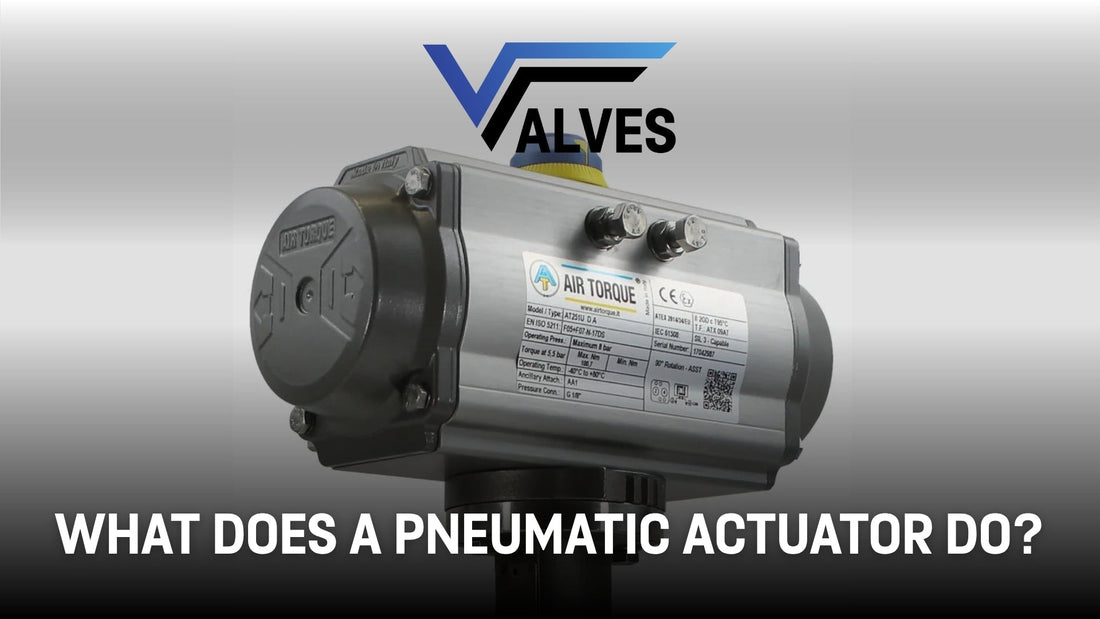
What Does a Pneumatic Actuator Do?
Share
A pneumatic actuator is a mechanical device that converts compressed air energy into motion — typically used to open, close, or control industrial valves. These actuators are integral to process automation across industries such as oil and gas, water treatment, chemical processing, and manufacturing. By using air pressure rather than electricity or hydraulics, pneumatic actuators deliver fast, reliable, and safe operation, particularly in environments where explosion risks or electrical hazards exist.
In simple terms, a pneumatic actuator takes the air pressure supplied to it and transforms it into linear or rotary motion, depending on the valve type it’s connected to. When air enters the actuator chamber, it pushes against a piston or diaphragm, creating motion that turns or lifts the valve stem. This movement enables precise control of flow, pressure, or temperature within a system — all without the need for manual intervention.
How Pneumatic Actuators Work
Pneumatic actuators operate on a straightforward principle: air in, motion out. Compressed air enters through an inlet port, filling one side of a chamber while venting air from the other. This pressure imbalance drives mechanical movement, which is then transferred to the valve.
There are two main types of pneumatic actuators:
Double Acting Pneumatic Actuators: Use air pressure to both open and close the valve, offering balanced control and faster cycling speeds.
Spring Return Pneumatic Actuators: Use air pressure for one direction (typically opening) and a spring mechanism for the return stroke, ideal for fail-safe operations where the valve must close automatically upon air supply loss.
In marine, industrial, and hazardous settings, pneumatic actuators are prized for their durability, simplicity, and low maintenance. They operate effectively across a wide temperature range and can be easily combined with positioners, solenoid valves, and limit switch boxes for advanced automation setups.
Benefits of Using Pneumatic Actuators
Fast and responsive operation with minimal delay between air signal and valve movement.
Safe for explosive environments, as they don’t rely on electrical power.
Low maintenance design with fewer moving parts than electric or hydraulic alternatives.
High torque output relative to actuator size, allowing control of large valves.
Reliability in demanding industrial environments where consistency is critical.
Whether controlling steam, gas, or liquid systems, pneumatic actuators offer unmatched dependability and are an essential component of modern process automation.
Popular Pneumatic Actuator Models
Several models have earned a reputation for reliability and precision control across industrial applications. Below are some of the most trusted and widely used pneumatic actuators available today:
Air Torque Double Acting Pneumatic Actuator – Known for its compact design and consistent torque delivery, perfect for automated on/off valve control in general process industries.
Air Torque Spring Return Pneumatic Actuator – A reliable fail-safe option using internal springs to ensure automatic valve closure upon air loss, ideal for safety-critical systems.
Festo DFPD-20-RP-90-RS60-F05 Pneumatic Actuator (Spring Return) – A compact, lightweight actuator perfect for smaller valves and low-torque applications, maintaining precision control.
Festo DFPD-120-RP-90-RS60-F05 F07 Pneumatic Actuator (Spring Return) – Designed for medium-duty valve automation, offering excellent corrosion resistance and reliability.
Festo DFPD-160-RP-90-RS60-F07 F10 Pneumatic Actuator (Spring Return) – Built for robust performance with precise control, featuring Festo’s advanced rack and pinion technology.
Festo DFPD-240-RP-90-RS60-F07 F10 Pneumatic Actuator (Spring Return) – High-torque model suited to larger valve assemblies, combining strength and efficient air consumption.
These models represent the leading edge of pneumatic actuator technology, offering efficient, safe, and long-lasting solutions for automated valve control across diverse industries.
Conclusion
So, what does a pneumatic actuator do? It transforms compressed air into mechanical motion — a simple yet powerful process that drives modern automation. From maintaining precise flow rates to ensuring emergency shutdowns, pneumatic actuators are indispensable wherever reliability and responsiveness are required.
Whether you need a double acting model for fast cycling or a spring return unit for safety-critical systems, these actuators deliver the performance and durability demanded by industrial environments worldwide.
FAQs
1. What is the main function of a pneumatic actuator?
A pneumatic actuator converts compressed air into mechanical motion to open, close, or modulate a valve.
2. What are the two main types of pneumatic actuators?
Double acting (air-to-open and air-to-close) and spring return (air-to-open, spring-to-close).
3. Why are pneumatic actuators preferred in hazardous areas?
Because they use air instead of electricity, making them safe in explosive or flammable environments.
4. Can pneumatic actuators be used with positioners and solenoids?
Yes, they can be integrated with positioners, solenoid valves, and limit switch boxes for enhanced automation control.
5. How long do pneumatic actuators last?
With proper maintenance and clean air supply, high-quality pneumatic actuators can last for many years in continuous operation.




